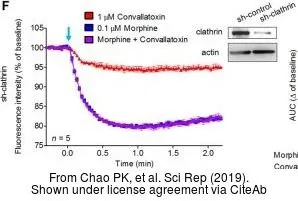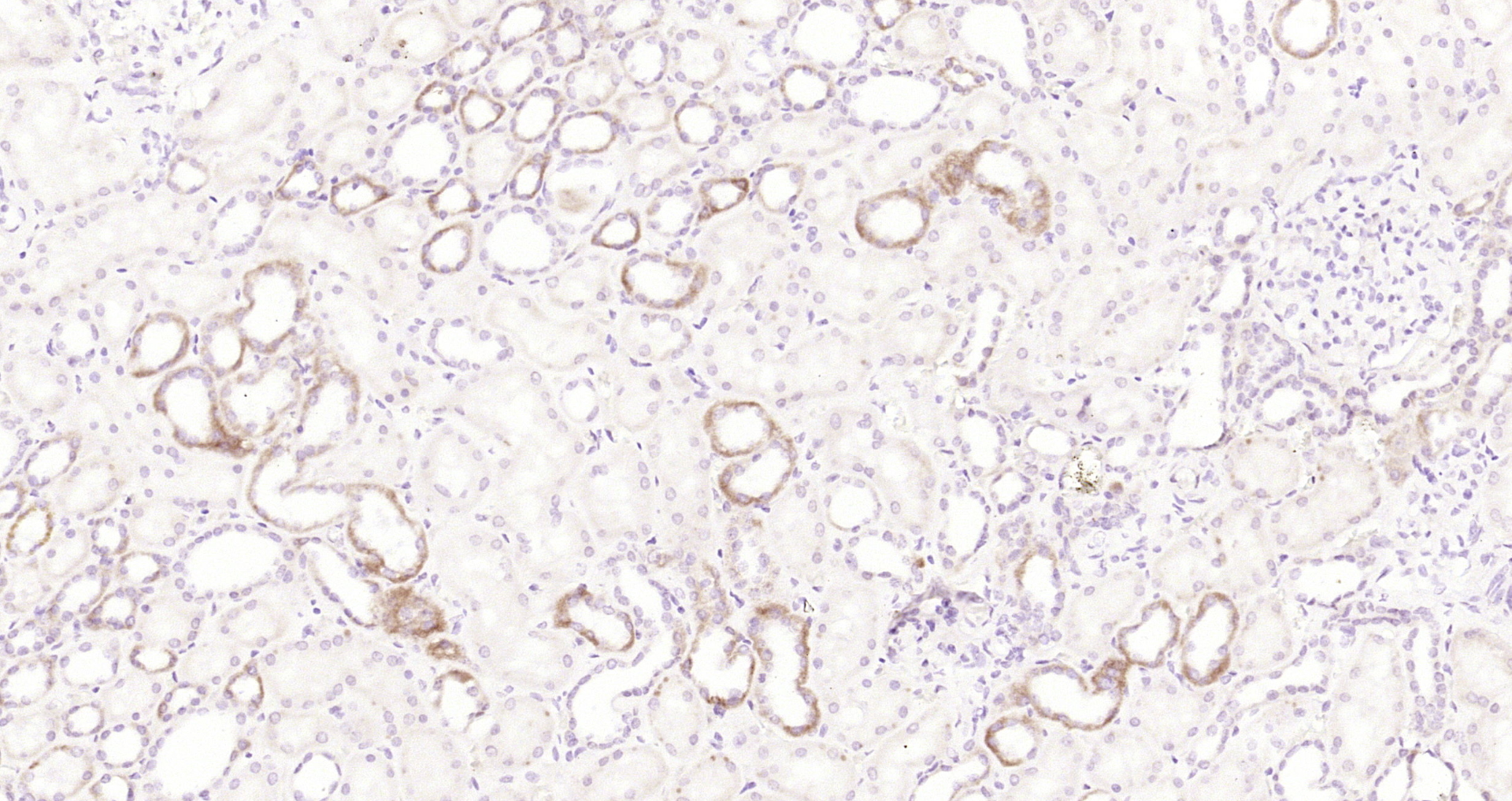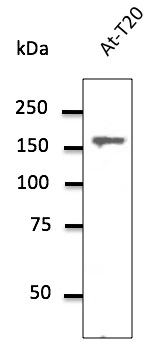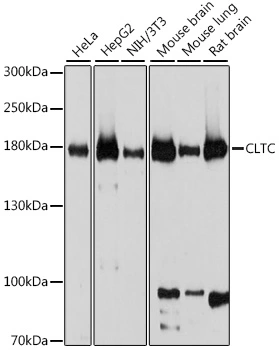![IHC-P analysis of human breast carcinoma tissue using GTX22731 Clathrin heavy chain antibody [X22]. Left : Primary antibody Right : Negative control without primary antibody Antigen retrieval : heat induced antigen retrieval was performed using 10mM sodium citrate (pH6.0) buffer, microwaved for 8-15 minutes Dilution : 1:100 IHC-P analysis of human breast carcinoma tissue using GTX22731 Clathrin heavy chain antibody [X22]. Left : Primary antibody Right : Negative control without primary antibody Antigen retrieval : heat induced antigen retrieval was performed using 10mM sodium citrate (pH6.0) buffer, microwaved for 8-15 minutes Dilution : 1:100](https://www.genetex.com/upload/website/prouct_img/normal/GTX22731/GTX22731_1085_IHC-P_w_23060620_173.webp)
IHC-P analysis of human breast carcinoma tissue using GTX22731 Clathrin heavy chain antibody [X22]. Left : Primary antibody Right : Negative control without primary antibody Antigen retrieval : heat induced antigen retrieval was performed using 10mM sodium citrate (pH6.0) buffer, microwaved for 8-15 minutes Dilution : 1:100
Clathrin heavy chain antibody [X22]
GTX22731
ApplicationsFlow Cytometry, ImmunoFluorescence, ImmunoPrecipitation, Western Blot, ImmunoCytoChemistry, ImmunoHistoChemistry, ImmunoHistoChemistry Frozen, ImmunoHistoChemistry Paraffin, Neutralisation/Blocking, Other Application
Product group Antibodies
TargetCLTC
Overview
- SupplierGeneTex
- Product NameClathrin heavy chain antibody [X22]
- Delivery Days Customer9
- Application Supplier NoteWB: 1:100-1:500. ICC/IF: 1:1,000. IHC-P: 1:100. FACS: 1/200. *Optimal dilutions/concentrations should be determined by the researcher.Not tested in other applications.
- ApplicationsFlow Cytometry, ImmunoFluorescence, ImmunoPrecipitation, Western Blot, ImmunoCytoChemistry, ImmunoHistoChemistry, ImmunoHistoChemistry Frozen, ImmunoHistoChemistry Paraffin, Neutralisation/Blocking, Other Application
- CertificationResearch Use Only
- ClonalityMonoclonal
- Clone IDX22
- Concentration6 mg/ml
- ConjugateUnconjugated
- Gene ID1213
- Target nameCLTC
- Target descriptionclathrin heavy chain
- Target synonymsCHC, CHC17, CLH-17, CLTCL2, Hc, MRD56, clathrin heavy chain 1, clathrin heavy chain on chromosome 17, clathrin, heavy polypeptide (Hc), clathrin, heavy polypeptide-like 2
- HostMouse
- IsotypeIgG1
- Protein IDQ00610
- Protein NameClathrin heavy chain 1
- Scientific DescriptionClathrin is a major protein component of the cytoplasmic face of intracellular organelles, called coated vesicles and coated pits. These specialized organelles are involved in the intracellular trafficking of receptors and endocytosis of a variety of macromolecules. The basic subunit of the clathrin coat is composed of three heavy chains and three light chains. [provided by RefSeq, Jul 2008]
- Storage Instruction-20°C or -80°C,2°C to 8°C
- UNSPSC12352203
References
- Chao PK, Chang HF, Ou LC, et al. Convallatoxin enhance the ligand-induced mu-opioid receptor endocytosis and attenuate morphine antinociceptive tolerance in mice. Sci Rep. 2019,9(1):2405. doi: 10.1038/s41598-019-39555-xRead this paper
- Smith TH, Coronel LJ, Li JG, et al. Protease-activated Receptor-4 Signaling and Trafficking Is Regulated by the Clathrin Adaptor Protein Complex-2 Independent of β-Arrestins. J Biol Chem. 2016,291(35):18453-64. doi: 10.1074/jbc.M116.729285Read this paper
- Parks EE, Ceresa BP. Cell surface epidermal growth factor receptors increase Src and c-Cbl activity and receptor ubiquitylation. J Biol Chem. 2014,289(37):25537-45. doi: 10.1074/jbc.M114.579581Read this paper
- Coradeghini R, Gioria S, García CP, et al. Size-dependent toxicity and cell interaction mechanisms of gold nanoparticles on mouse fibroblasts. Toxicol Lett. 2013,217(3):205-16. doi: 10.1016/j.toxlet.2012.11.022Read this paper
- Ricks TK, Trejo J. Phosphorylation of protease-activated receptor-2 differentially regulates desensitization and internalization. J Biol Chem. 2009,284(49):34444-57. doi: 10.1074/jbc.M109.048942Read this paper

![IHC-P analysis of human colon tissue using GTX22731 Clathrin heavy chain antibody [X22]. Left : Primary antibody Right : Negative control without primary antibody Antigen retrieval : heat induced antigen retrieval was performed using 10mM sodium citrate (pH6.0) buffer, microwaved for 8-15 minutes Dilution : 1:100 IHC-P analysis of human colon tissue using GTX22731 Clathrin heavy chain antibody [X22]. Left : Primary antibody Right : Negative control without primary antibody Antigen retrieval : heat induced antigen retrieval was performed using 10mM sodium citrate (pH6.0) buffer, microwaved for 8-15 minutes Dilution : 1:100](https://www.genetex.com/upload/website/prouct_img/normal/GTX22731/GTX22731_1086_IHC-P_w_23060620_698.webp)
![WB analysis of 25 ug of human brain lysates using GTX22731 Clathrin heavy chain antibody [X22]. Dilution : 1:300 WB analysis of 25 ug of human brain lysates using GTX22731 Clathrin heavy chain antibody [X22]. Dilution : 1:300](https://www.genetex.com/upload/website/prouct_img/normal/GTX22731/GTX22731_1577_WB_w_23060620_365.webp)

![ICC/IF analysis of HeLa cells using GTX22731 Clathrin heavy chain antibody [X22]. Cells were probed without (right) or with(left) an antibody. Green : Primary antibody Blue : Nuclei Red : Actin Fixation : formaldehyde Dilution : 1:200 overnight at 4oC ICC/IF analysis of HeLa cells using GTX22731 Clathrin heavy chain antibody [X22]. Cells were probed without (right) or with(left) an antibody. Green : Primary antibody Blue : Nuclei Red : Actin Fixation : formaldehyde Dilution : 1:200 overnight at 4oC](https://www.genetex.com/upload/website/prouct_img/normal/GTX22731/GTX22731_398_ICC-IF_w_23060620_239.webp)
![ICC/IF analysis of NCI-H460 Cells using GTX22731 Clathrin heavy chain antibody [X22]. Cells were probed without (right) or with(left) an antibody. Green : Primary antibody Blue : Nuclei Red : Actin Fixation : formaldehyde Dilution : 1:200 overnight at 4oC ICC/IF analysis of NCI-H460 Cells using GTX22731 Clathrin heavy chain antibody [X22]. Cells were probed without (right) or with(left) an antibody. Green : Primary antibody Blue : Nuclei Red : Actin Fixation : formaldehyde Dilution : 1:200 overnight at 4oC](https://www.genetex.com/upload/website/prouct_img/normal/GTX22731/GTX22731_399_ICC-IF_w_23060620_800.webp)
![ICC/IF analysis of U251 cells using GTX22731 Clathrin heavy chain antibody [X22]. Cells were probed without (right) or with(left) an antibody. Green : Primary antibody Blue : Nuclei Red : Actin Fixation : formaldehyde Dilution : 1:200 overnight at 4oC ICC/IF analysis of U251 cells using GTX22731 Clathrin heavy chain antibody [X22]. Cells were probed without (right) or with(left) an antibody. Green : Primary antibody Blue : Nuclei Red : Actin Fixation : formaldehyde Dilution : 1:200 overnight at 4oC](https://www.genetex.com/upload/website/prouct_img/normal/GTX22731/GTX22731_400_ICC-IF_w_23060620_636.webp)






![ICC/IF analysis of HeLa cells using GTX80218 Clathrin Heavy chain antibody [BF-06]. Green : Primary antibody Red : Actin Blue : DAPI](https://www.genetex.com/upload/website/prouct_img/normal/GTX80218/GTX80218_20191028_ICC-IF_1_w_23061322_939.webp)